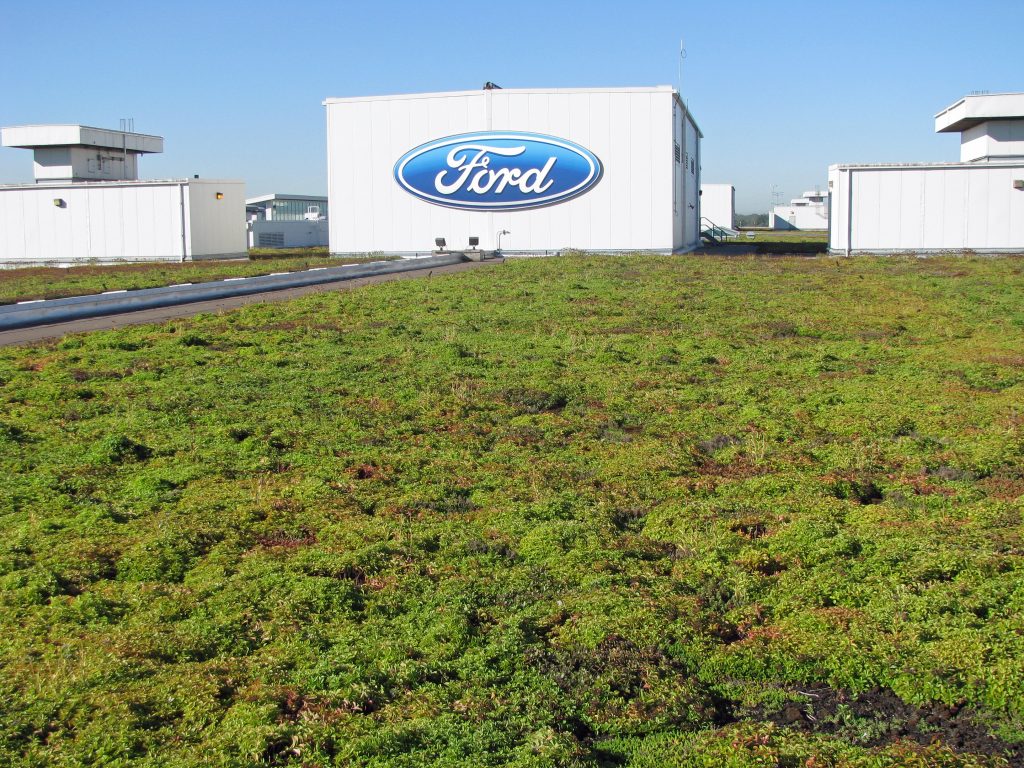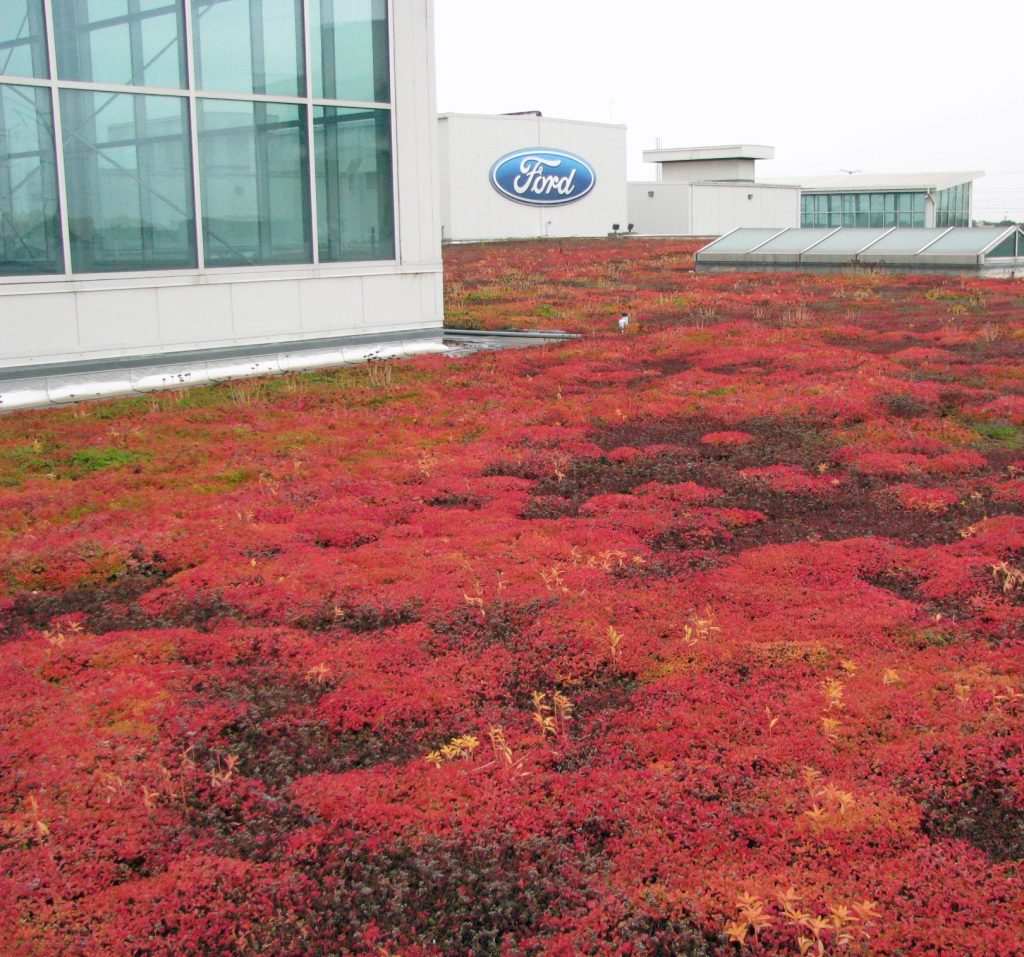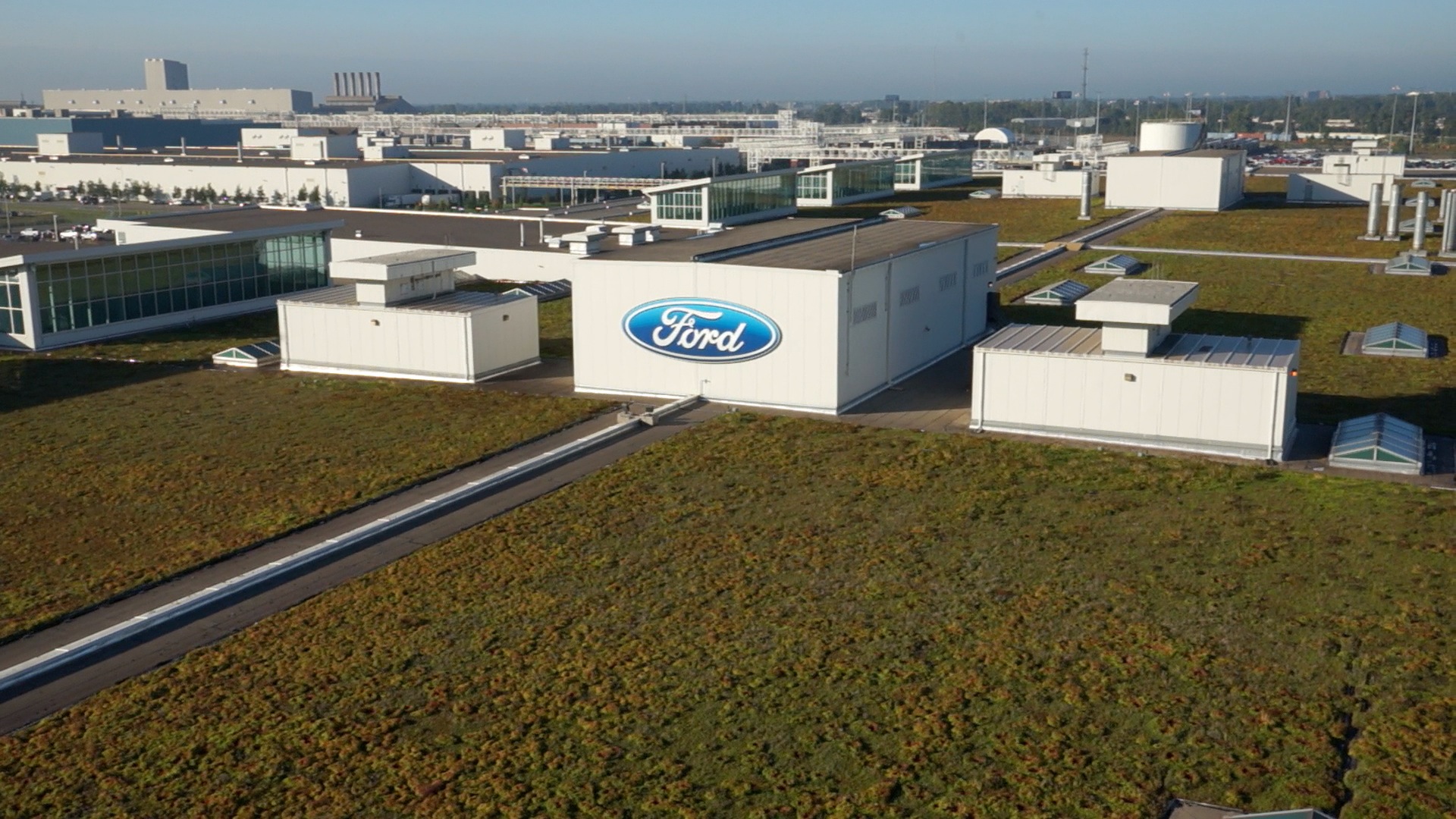When I first installed the green roof at Good Earth Plant Company in 2007, all of the information about the long term impact came from Europe. There weren’t all that many green roofs in the United States and there weren’t many studies being conducted on the few that existed.
Times change and we are much more enlightened about the positive impact of green roofs on the immediate environment and their contribution overall. Some of the best studies are coming from The Green Roof Research Program at Michigan State University. One of MSU’s collaborators is a company which might not come to mind when you think about green roofs: the Ford Motor Company. Yes, the same company known for big trucks and the Mustang sports car. Ford gets a lot of credit from me for its efforts to advance our knowledge about green roofs and to promote their use.

The Ford Dearborn green roof is 10.4 acres, planted mainly with sedum. It hasn’t needed any irrigation for the last seven years!
MSU received a research grant from Ford in 2000, with Dr. Clayton Rugh and Dr. Brad Rowe as the co-principal investigators. Dr. Rugh and Dr. Rowe evaluated different green roof strategies and systems in various trials, and eventually recommended the Xero Flor system to Ford as part of its massive two billion dollar renovation of the historic River Rouge truck plant in Dearborn, Michigan. Dr. Rugh now works as Xero Flor’s director.
I asked Clayton (I can call him this, I’ve known him for many years) to tell me more about the Ford green roof project. He gave most of the credit to pioneering American designer Bill McDonough and his firm McDonough + Partners. Dr. Rugh said it was Bill who conveyed the initial idea for the many eco-friendly features including the green roof idea to William Clay Ford, which ultimately resulted in the green roof and the many other forward thinking features becoming part of the massive re-engineering of the Dearborn River Rouge truck assembly plant.
McDonough had completed big projects for The Gap and Nike, which led to the Ford project. McDonough, Xero Flor International, along with MSU as a technical consultant worked to make the roof a reality.
The roof continues to flourish and it is providing a tremendous amount of long term research data about the benefits of green roofs. Dr. Rugh provided me this 2014 photo showing how the roof experiences the change in seasons.

A look at the Ford truck plant’s green roof showing autumn season leaf colors. Photo: Courtesy Dr. Clayton Rugh
MSU’s program has studied energy conversation and microclimate moderation, plant moisture requirements, drought tolerance, pollution effects and mitigation, stormwater management, carbon sequestration, urban heat islands, urban agriculture, wildlife habitats and biodiversity.
See Ford’s Dearborn roof in this 2013 video. Tell me you aren’t inspired after watching this!
The Dearborn plant’s green roof has been a money saver for Ford. It reduces heating and cooling costs down year-round by keeping the plant 10 degrees warmer in winter and 10 degrees cooler in summer. MSU research says it results in a five percent cost savings. For a plant this large, it runs into the millions of dollars. The green roof also reduces the urban heat island effect, and protects the roof from ultraviolet radiation damage. If you’ve ever had furniture fade due to sunlight exposure, you know what this is like. MSU’s researchers believe the green roof will double the life of the roof compared to a conventional roof. This is another multi-million dollar cost savings and avoids a logistics nightmare of keeping the plant running while replacing a roof this size.
Ford and its shareholders love the economic benefits. But it can also feel good about its environmental benefits. The Dearborn roof collects and filters rain and snow, significantly reducing the amount of storm water and contaminants flowing into the nearby Rouge River watershed.
The roof traps airborne dust and dirt when it’s not raining as well. It absorbs carbon dioxide and creates oxygen to improve overall air quality.
The living roof is its own ecosystem. It is home to 35 different insect, spider, and bird species. There are 11 different types of plants, including some natives which have made the roof their home.
Michigan State University’s studies find the cost to install a green roof is about 30 to 35 percent more than an equivalent traditional roof. But the green roof will recoup the investment in energy savings over the life of the roof. And considering how much longer a green roof will last over a conventional roof, it is an excellent long term investment.
But even more important to me than the financial kind of green is the positive environmental impact. Every single aspect of the environment – air quality, water quality, global warming, biodiversity – is improved by a green roof because of its simple existence. And if you think about it, a green roof is the only part of a building that improves with age.
When you combine the cost savings with the contribution to the environment, it’s surprising we aren’t working harder as a society to install more green roofs overall.

Various plants, insects and animals have come to depend on what is now a thriving ecosystem that equates to a 10.4-acre garden. The living roof also serves as a cost-effective alternative to roof maintenance for Ford, while keeping heating and cooling costs in check for the factory underneath.
If you need more convincing, I encourage you to visit the Michigan State University Green Roof Research Project website. MSU runs experiments on nine green roofs spread all over its campus. Wouldn’t you love to see some of San Diego’s respected colleges and universities adding green roofs to their campuses and curriculum?
We have many decisions to make about civic planning and land-use in San Diego in the near future. Development is booming thanks to an improved economy. We as citizens and taxpayers need to educate ourselves and then keep this issues front and center when projects are proposed in our region and our neighborhoods. Could the design and the plan incorporate a green roof? If not, how about a living wall or other eco-friendly building integrated vegetation elements?
Remember, these decisions makers work for US, the voters and taxpayers. Take advantage of the opportunity to communicate about these issues. Provide the research produced institutions like Michigan State University that show the value of this investment.
We can increase public adoption of these eco-friendly elements by communicating with our representatives and educating them. Good public policy decisions should follow. At least we give it a chance to happen.
NOTE: You can learn more about William McDonough’s contribution to this field in this 2005 TED talk.

